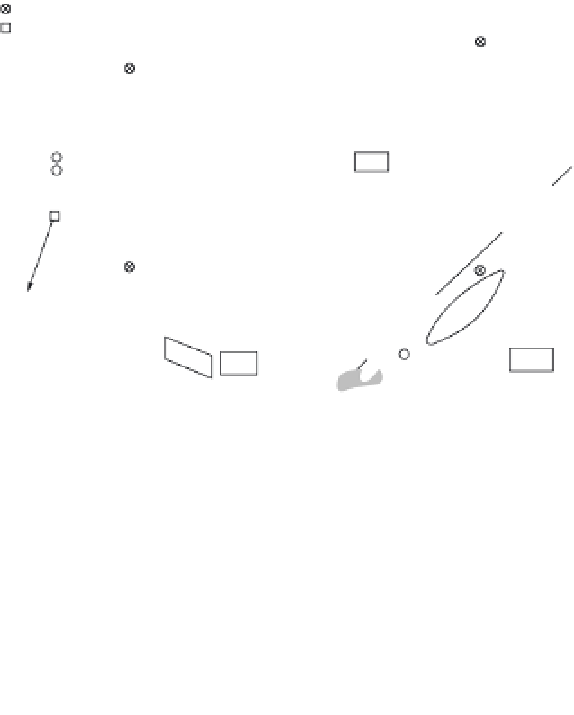Geoscience Reference
In-Depth Information
14
12
10
8
6
4
16
12
PICLOGITE
COSMIC
STP
Hz
PICR
MORB
PICR
CaO
8
PM
ECL
MORB
PETROLOGICAL
MODELS
LHERZOLITE
LZ
STP
PM
4
cpx
LOWER
MANTLE
LZ
FeO
ECL
MORB
0
HZ
12
PICR
MORB
ECL
PICR
48
LZ
STP
8
ECLOGITE
PICRITE
PERIDOTITIC
KOMATIITE
PM
44
STP
PM
4
gf
HZ
Al
2
O
3
SiO
2
40
LZ
HARZBURGITE
0
50
40
30
20
10
0
50
40
30
20
10
0
MgO (weight percent)
Fig. 15.2
Oxides versus MgO for igneous rocks. The basalt
source region probably has a composition intermediate
between basalt (MORB) and harzburgite. Most petrological
models (PM) of the major-element chemistry of the source
region favor a small basalt fraction. STP (spinifex textured
peridotites) are high-temperature MgO-rich magmas. Picrites
(PICR) are intermediate in composition between STP and
MORB and may evolve to MORB by olivine separation.
Picrites and eclogites (ECL) overlap in composition.
Lherzolites (LZ) contain an orthopyroxene component, but
the other rock types are mainly clinopyroxene
+
garnet and
olivine. Squares represent estimates of primitive mantle
composition based on a chondritic model. If the upper mantle
is primarily lherzolite, basalt and harzburgite, the lower
mantle (open dot) will be primarily orthopyroxene. The
composition of the MORB source (piclogite model) probably
falls between PICR and PM or STP.
generally consistent with variable amounts of a
basaltic component. However, the basaltic com-
ponent is not tholeiitic or MORB. If lherzolites
represent olivine--orthopyroxene-rich rocks with
variable amounts of melt extraction or addition,
this melt component is andesitic in major ele-
ments.
The major-element trends of lherzolites may
also be controlled by melt-crystal equilibration
at various depths in the mantle. Lherzolites,
and most other ultramafic rocks, are generally
thought to be the refractory residue comple-
mentary to melts presently being extracted from
the mantle. They differ, however, from primitive
mantle compositions. In particular they contain
more olivine and less orthopyroxene than would
be appropriate for a chondritic or 'cosmic' man-
tle. Upper-mantle lherzolites and basalts may be
complementary to the lower mantle, represent-
ing melts from the original, accretional differ-
entiation of the mantle. The MgO content of
melts increases with temperature and with depth
of
Lherzolites typically contain 60--80% olivine,
20--40% orthopyroxene, less than 14% clinopyrox-
ene and 1--10% of an aluminous phase such as
spinel or garnet. Spinel lherzolites, the lower-
pressure assemblages, dredged from the ocean
bottom are similar in composition to those found
in alkali basalts and kimberlites on oceanic
islands and continents. Garnet lherzolites are
denser than spinel lherzolites only when they
contain appreciable garnet. They would become
less dense at higher temperature, lower pressure
or if partially molten.
The major-element chemistries of lherzolites
vary in a systematic fashion. Most of the oxides
vary linearly with MgO content. These trends are
200 km) relati-
vely low-MgO phases, such as orthopyroxene
and garnet--majorite may remain behind, giv-
ing olivine-rich melts. The major-element trends
in lherzolites may therefore represent trends in
high-pressure melts. Unserpentinized peridotites
have seismic velocities and anisotropies appro-
priate for the shallow mantle. This situation is
often generalized to the whole mantle, but seis-
mic data for depths greater than 400 km are
melting.
At
great
depth
(
>















































